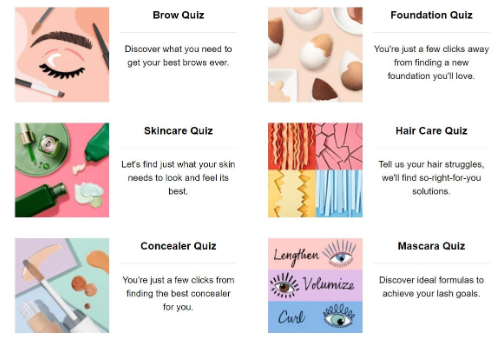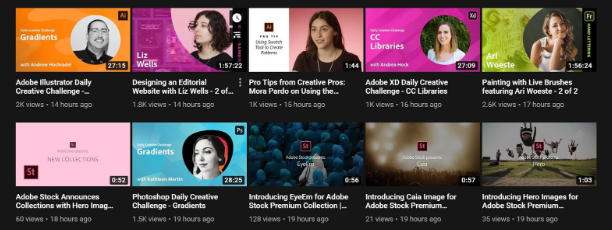Marketing plays a significant role in growing an e-commerce business.
You need a social media page to consistently promote your content to your customer base. You need to create marketing campaigns and generate buzz for your brand.
If your business is on a budget, then how do you get started? In this post, we’ll cover different growth tactics for entrepreneurs that are looking to start their own e-commerce business from scratch. Here are some strategies that require minimal or zero budget that will set you up for long term success.
1. Using interactive quizzes
Interactive quizzes can help you personalize your content and product offerings. Instead of browsing a product catalog for hours on end, they can answer a quiz that will help you understand them better.
In fact, a study found that interactive content like assessments and quizzes can generate conversions effectively 70% of the time, as compared to just 36% for passive content. Also, 66% of marketers reported a boost in audience engagement after implementing interactive content.
Brands like Sephora have utilized interactive content to help customers find products that will suit their preferences. Their skincare quiz lets users discover products that they need to look their best.
Once users finish answering the questions, they get personalized product recommendations based on their needs.
These short and simple quizzes can help you create better product recommendations. Also, you can use it to find the wants and needs of your target market.
2. Create a referral program
Referral programs reward shoppers for advocating your e-commerce business. Incentives like discounts and freebies motivate people to make an effort and spread the word about their customer experience.
In fact, 49% of consumers believe their friends and family are their top sources of brand awareness. Meanwhile, 39% of shoppers think gift cards, freebies or discounts are factors that can increase their chances of referring to a brand.
Having said that, referral marketing is an effective word-of-mouth strategy in garnering publicity for your brand. Consumers will likely patronize your business when they receive tokens in return, either big or small.
For example, ibotta offers a $50 cashback for successfully promoting their business to five friends. They promoted their product through email marketing.
This offer encourages people to share the business in their social media profiles and communicate it to their followers. It’s essentially the same as paying a brand ambassador for a new customer.
Those who have a huge social media following may be encouraged to share it with their Instagram followers too. Think of it as paying your brand advocates for a new customer. It is a great way of leveraging the Instagram profile for business to build awareness around it.
Damian Grabarczyk, the co-founder and growth marketer of PetLab Co., says, “In our early days, we launched the ‘Change A Dog’s Life’ referral program to harness the power of word-of-mouth marketing. The program offers $10 off for both the referrer and their friend on a purchase of $28 or more. This strategy, initially aimed at gaining traction in a crowded market, worked remarkably well. It drove immediate sales and helped us build a loyal customer base. The ongoing success of this program demonstrates the lasting impact of leveraging satisfied customers as brand advocates. This referral program continues to drive our growth, significantly boosting our customer acquisition and retention rates. By creating a win-win situation for both existing and new customers, we have managed to sustain engagement and loyalty, making our referral strategy a cornerstone of our marketing efforts.”
Tools like Pointerpro offer easy to interpret reports and visualizations, meaning that you’ll quickly be turning your data into results. These results can be put in a wide variety of charts and tables to present them to your boss, colleagues, clients or customers.
3. Loyalty program
Increasing customer retention is important for a business’s growth.
A study found 20% of loyal customers contributed to 80% of businesses’ profits. That’s why 82% of companies agree that retention is cheaper than acquisition and increasing retention by only 5% can boost profits by 25% to 95%.
Not surprisingly, we earn more from past customers that trust the brand because of their previous experience. In contrast, new customers have to be led across the customer journey before they can make a purchase. So, making customers loyal can have a significant impact on business growth.
Now, how can you boost customer loyalty? A punch card loyalty program can reward customers through discounts and freebies in exchange for a repeat purchase. You can share a digital business card that includes a loyalty program code for repeat customers, for easy access and sharing with friends and family. Check online resources to find the best digital business card software to create this card.
For example, the Red Robin Royalty Program encourages customers to visit 5 times in the first 5 weeks. They must purchase a burger, entree, full-sized salad or sandwich for each visit. In exchange, they get a $20 reward that they could use during their 6th visit.

If you want to create a loyalty program, then you can use tools like Candybar. The app can be immediately set up in your store. You can even track regulars and download customer data through an easy to use dashboard.
4. Deliver personalized product recommendations
We’ve heard e-commerce experts rave about product recommendations, and for good reason.
We inevitably click products that cater to our interests. Instead of taking the time to find a product, we want to see the best selling items on Etsy that we like immediately.
As a result, product recommendations are effective at keeping customers in your online store.
In fact, Barilliance found that sessions without recommendations have an Average Order Value (AOV) of $44.41. The AOV dramatically increases to $208 with a single product recommendation, then maxes out at $416 at around 5 clicks.
Placing product recommendations can increase customer engagement and encourage more purchases in the long-run. The Amazon website draws in customers through personalized product recommendations like “Based on items you viewed”, “Recently Viewed” “Deals” and more.

5. Post informative product descriptions
Many e-commerce stores write subpar product recommendations and focus on product photography, website design, and promoting top reviews instead. While all these elements are important to an online store, a product recommendation can give customers reasons to buy your product. Explore AI based tools to come up with ideas for product descriptions, but ensure you have a clear corporate AI policy detailing the ways data privacy will be addressed.
For example, Glossier’s product description provides basic details like the product name and the amount of formula. It also adds a bullet list of items that show why the product is special, plus good to know features like hypoallergenic, dermatologist tested and vegan.
Customers are provided with all the information that they need to make a purchase. There are also icons featuring the shades available and the benefits of using the product such as nourishing and enhancing.
6. Utilize guerilla marketing
Guerilla marketing involves utilizing low-cost marketing techniques to get the most exposure for your product.
Some businesses have leveraged interactive displays and social media tools to create memorable customer experiences. Others hire graffiti artists and leverage massive creative stickers for their marketing plan.
For example, Fantastic Delites – a food brand – tested how far people will go to get a free package through a creative campaign. They placed a vending machine in the middle of the shopping center while users pushed a button to get a free package.
After a customer finished each challenge, the level of difficulty increased. Some had to push a button 5000 times and others had to accomplish push-ups and jumping jacks.
7. Vlogs, live sessions and interviews
Video marketing can generate a lot of views and buzz for your brand.
Oberlo found that 54% of consumers want to get more video content from a brand that they love. Meanwhile, 87% of marketing professionals use video as a marketing tool.
Video marketing can inevitably help businesses connect with their audience. For example, Adobe attracts the creative community through live streaming sessions and events. They create tutorial videos and have interviews with industry professionals.
How will you market your own products?
Let’s recap.
Here are some inexpensive yet efficient marketing tactics that you can use to grow your business:
- Use interactive quizzes
- Create a referral program
- Launch a loyalty program
- Deliver personalized product recommendations
- Post informative product descriptions
- Utilize guerilla marketing
- Vlogs, live sessions, and interviews
You’ll need to implement creative tactics to attract your audience’s attention. Brainstorm motivating rewards for referral and loyalty programs.
Leverage personalized product recommendations. Use interactive quizzes with personalized recommendations. Implement an exciting guerilla marketing campaign and use product descriptions to convince customers that your products are special.
What are the non-traditional marketing tactics that you will use to promote your e-commerce business? Let us know in the comments below.















